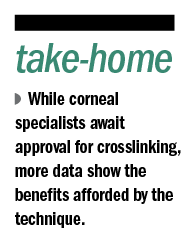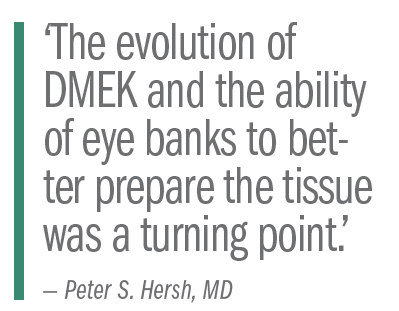Article
What’s new in corneal surgery in 2015
Corneal surgeons thought 2015 would be the year that collagen crosslinking (CXL) for the treatment of keratoconus would be approved in the United States, but the FDA’s decision on Avedro’s KXL system is not expected until April 2016.
Reviewed by Peter S. Hersh, MD
Corneal surgeons thought 2015 would be the year that collagen crosslinking (CXL) for the treatment of keratoconus would be approved in the United States, but the FDA’s decision on Avedro’s KXL system is not expected until April 2016.
“I’m hopeful we’ll see an FDA approval for crosslinking in the next year,” said Jonathan H. Talamo, MD, of Mass. Eye and Ear, Boston. Part of the difficulty in getting a de

vice for keratoconus approved is that keratoconus itself is an orphan condition and there are not a lot of companies pursuing it, he said.
The company, however, seems determined to work with the FDA to get the KXL-under review for not only progressive keratoconus, but corneal ectasia following refractive surgery-approved and in the hands of surgeons, he noted. The company received support for approval in both indications in February, but the FDA had concerns about the design of the device.
News: CA-CXL now including candidates with thin corneas
“There were no clinical questions on the safety or efficacy of the procedure as demonstrated in the U.S. multicenter clinical trial,” said Peter S. Hersh, MD, of The Cornea and Laser Eye Institute-Hersh Vision Group, Teaneck, NJ, who serves as medical monitor for Avedro.
“It’s hard to believe that crosslinking is not approved yet in this country,” said Ernest W. Kornmehl, MD, of Kornmehl Laser Eye Associates, Brookline, MA, as crosslinking is already approved in several European countries and in China. He believes the data with results that support the need for approval will make 2016 the year a device enters the U.S. market.
“Clearly, ophthalmology, corneal surgeons, and keratoconus patients all are awaiting this with great eagerness, especially our patients,” Dr. Hersh said. “From having done a lot of crosslinking and being monitor of these trials, this is clearly a procedure that is efficacious for the patients and the one thing that we would now have to decrease disease progression in these patients.”
Next: Crosslinking in the United States
Presuming crosslinking does eventually receive U.S. regulatory approval, adjunctive procedures could be helpful as well, Dr. Hersh said. For instance, outside the United States, surgeons are combining topography-guided PRK with crosslinking, or manipulating the corneal shape with intracorneal ring segments or an implantable contact lens.
“What we’re trying to do is stabilize the disease, where crosslinking has the best potential, and then treat the corneal optics,” he said. “One study that we have been doing is showing encouraging results combining crosslinking with intracorneal ring segments. The crosslinking appears to stabilize the disease process and the Intacs improves the corneal optics.”
Related: A closer look at riboflavin application for crosslinking
Crosslinking for refractive errors is an especially interesting potential modality of the crosslinking platform and clinicians will see more results in the new year, Dr. Hersh predicted. Potentially, crosslinking may be used as an alternative to LASIK to correct lower degrees of myopia, astigmatism, and hyperopia.
“This is being investigated overseas where the topography-guided KXL II system is being used to guide the ultraviolet energy,” he said. “Topography-guided crosslinking could potentially enhance results in keratoconus patients because it may be able to give the patients a greater topographic result as well as stabilization, since the UV power and pattern are custom designed for the individual patient corneal topography.
“In addition, refractive correction can be achieved through application of customized, zone-specific UV irradiation patterns. Early studies of the photorefractive intrastromal crosslinking procedure (PiXL) out of Europe have been very encouraging,” with good accuracy and stability reported out to 12 months in patients treated with myopia of up to –3.0 D, he noted.
Next: Corneal transplant surgeries
Corneal transplant surgeries

Descemet’s membrane endothelial keratoplasty (DMEK)-where only Descemet’s membrane and endothelium are grafted-boasts potentially better visual outcomes and quicker healing times than Descemet’s stripping endothelial keratoplasty (DSEK) or Descemet’s stripping automated endothelial keratoplasty (DSAEK). However, some surgeons may experience that the learning curve with DMEK can be high as the procedure itself can be technically challenging.
“In 2015, the evolution of DMEK and the ability of eye banks to better prepare the tissue was a turning point,” Dr. Hersh said. Stripping Descemet’s and endothelium from a donor cornea is readily acknowledged as one of the most difficult aspects of the procedure, but eye banks are beginning to prepare more and more of the donor tissue, easing the challenges a bit. Several surgeons have introduced tools to help keep the graft in position and prevent tearing.
Practice management: Keeping priorities right in your practice
On the other side of lamellar surgery developments, deep anterior lamellar keratoplasty is increasing in popularity.
“We like to use the femtosecond laser to make a mushroom pattern. In addition, we use the laser to dissect a wide lamellar corneal plane. This facilitates the placement of a big bubble,” Dr. Hersh said.
With DALK, “we can adjust the sutures for astigmatism early postoperatively, and get excellent optical results,” he said.
Peter S. Hersh, MD
e: phersh@vision-institute.com
Dr. Hersh has financial interest with Addition Technology, Avedro Inc., and Synergeyes Inc.
Newsletter
Don’t miss out—get Ophthalmology Times updates on the latest clinical advancements and expert interviews, straight to your inbox.




